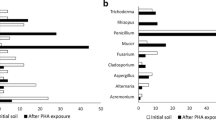Abstract
Microorganisms which can assimilate a new polyester synthesized from polyethylene glycol (PEG) as a dihydroxyl compound and phthalic acid as a dicarboxyl compound were isolated from soils by enrichment culture techniques. Two cultures, K and N, were obtained: Culture K grew on PEG 4000 polyester and culture N assimilated PEG 6000 polyester. Each culture included two bacteria indispensable for the degradation of polyesters: bacteria K1 and K2 for PEG 4000 polyester-utilizing culture K and bacteria N1 and N2 for PEG 6000 polyester-utilizing culture N. Bacteria K2 and N2 were responsible for the hydrolysis of ester bonds in a polyester and both were identified as the same species,Comamonas acidovorans. Bacteria K1 and N6 could assimilate PEG as a sole carbon and energy source. Both are Gram-negative, non-spore-forming rods and resembled each other on their colony characteristics, although strain K1 could not grow on PEG 6000.C. acidovorans N2 (K2) grew on dialkyl phthalates (C2–C4) and phthalate and tributyrin, but not on PEG, diphthalic PEG, and PEG phthalate polyesters. Their culture supernatant and washed cells hydrolyzed PEG (400–20,000) phthalate and sebacate polyesters.C. acidovorans had higher esterase activity toward PEG phthalate, isophthalate, and terephthalate polyesters than known esterase and lipases. The esterase seemed to be an extracellular one and attached to the cell surface.
Similar content being viewed by others
References
F. Kawai (1987)CRC Crit. Rev. Biotechnol. 6, 273–307.
A. Sugiharaet al. (1994)Biosci. Biotech. Biochem. 58, 752–755.
Y. Shimadaet al. (1993)J. Ferment. Bioeng. 75, 349–352.
Dai-ichi Kogyo Seiyaku Co., Ltd., Japan. Patent 1993-68493 (JP, B2).
J. G. Holtet al. (Eds.) (1984, 1989)Bergey's Manual of Systematic Bacteriology, Vols. 1–4, Williams and Wilkins, Baltimore.
J. E. Pottset al. (1972)Am. Chem. Soc. Polym. Reprints 13, 629.
R. D. Fieldset al. (1974)J. Appl. Polym. Sci. 18, 3571–3579.
S. J. Huanget al. (1976)Proc. 3rd Int. Biodegrad. Symp., pp. 731–741.
Y. Tokiwa and T. Suzuki (1976)J. Ferment. Technol. 54, 603–608.
Y. Tokiwa and T. Suzuki (1977)Nature 270, 76–78.
Y. Tokiwaet al. (1990) in J. E. Glass and G. Swift (Eds.),Agr. Synth. Polym., Am. Chem. Soc., Washington, DC, pp. 136–148.
S. Heidary and B. Gordon III (1994)J. Environ. Pol. Degrad. 2, 19–26.
R. W. Eaton and D. W. Ribbons (1982)J. Bacteriol. 151, 48–57.
C. Engelhardt and P. R. Wallnofer (1978)Appl. Environ. Microbiol. 35, 243–246.
B. F. Tayloret al. (1981).Appl. Environ. Microbiol. 42, 590–595.
R. Kuraneet al. (1977)Agr. Biol. Chem. 41, 1031–1038.
R. Kuraneet al. (1977)Agr. Biol. Chem. 41, 2119–2123.
V. W. Saeger and E. S. Tucker (1976)Appl. Environ. Microbiol. 31, 29–34.
E. L. Fincher and W. J. Payne (1962)Appl. Microbiol. 10, 542.
M. Takeuchiet al. (1993)Syst. Appl. Micobiol. 16, 227–238.
Author information
Authors and Affiliations
Rights and permissions
About this article
Cite this article
Kawai, F. Bacterial degradation of a new polyester, polyethylene glycol-phthalate polyester. J Environ Polym Degr 4, 21–28 (1996). https://doi.org/10.1007/BF02083879
Issue Date:
DOI: https://doi.org/10.1007/BF02083879




